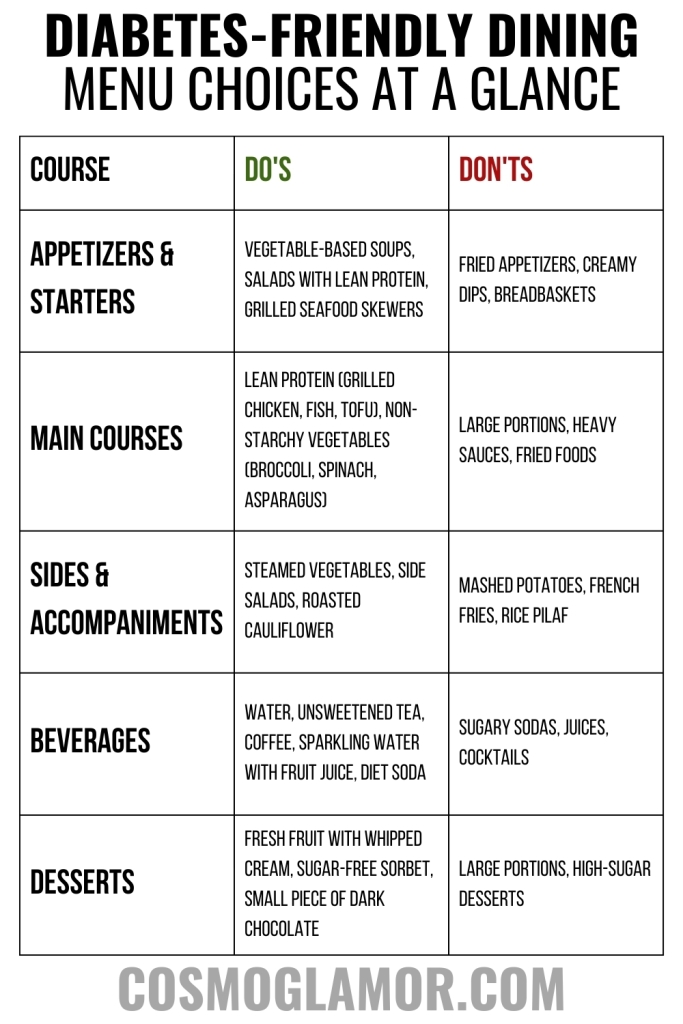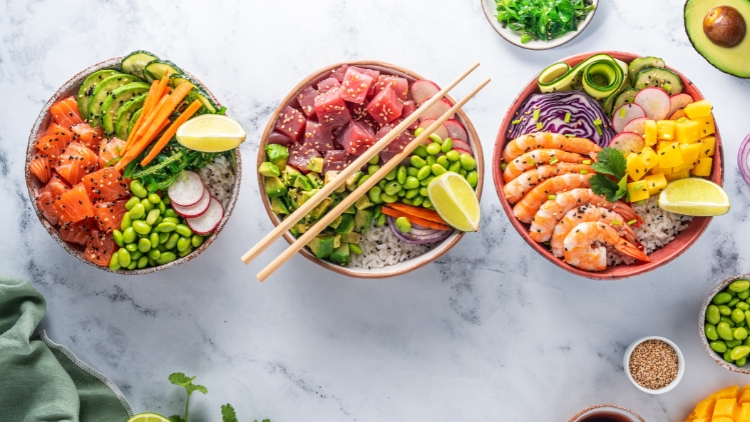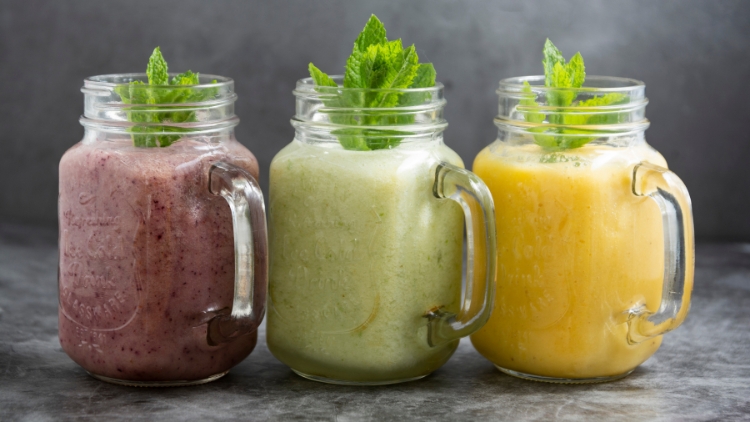Imagine this: the aroma of freshly baked bread fills the air, the clinking of glasses creates a symphony of anticipation, and a colorful array of dishes tantalizes your eyes. It’s a scene that excites anyone who loves to dine out. But for individuals with diabetes, this picture-perfect moment can sometimes be overshadowed by a wave of anxiety. Questions like, “Can I enjoy this without spiking my blood sugar?” or “Will this meal derail my dietary efforts?” often creep in.
“I used to avoid restaurants altogether,” shares Maria, a woman living with type 2 diabetes. “But then I realized I was missing out on so much. Now, with a bit of planning, I can enjoy meals out just like anyone else.”
Maria’s story is a testament that dining out doesn’t have to be a source of worry. With a little planning and knowledge, individuals with diabetes can confidently navigate restaurant menus and savor the joy of eating out, worry-free. This article is your guide to doing just that. We’ll delve into practical tips, expert advice, and real-life strategies to empower you to make informed choices, manage your blood sugar levels, and truly relish every dining experience. So, let’s embark on this culinary journey together, transforming dining out from a potential challenge into a delightful adventure.
Understanding the Impact of Dining Out on Blood Sugar

Before we dive into the practical tips, it’s important to understand how dining out can affect blood sugar levels. Restaurant meals often contain hidden sugars, larger portion sizes, and higher carbohydrate content than home-cooked meals. These factors can contribute to blood sugar spikes if not managed carefully.
- Hidden Sugars: Many restaurant dishes, especially sauces, dressings, and desserts, contain added sugars that can quickly raise blood sugar levels.
- Portion Sizes: Restaurants are notorious for their generous portion sizes, which can make it challenging to control carbohydrate intake.
- Carbohydrate Content: Many popular restaurant dishes are rich in carbohydrates, which directly impact blood sugar levels.
Understanding these potential challenges is the first step towards making informed choices and enjoying worry-free dining experiences.
Pre-Dining Preparation: Setting the Stage for Success
A little preparation before heading out can go a long way in ensuring a smooth dining experience.
-
Research the Restaurant: In today’s digital age, most restaurants have their menus available online. Take some time to browse the menu beforehand and identify dishes that are lower in carbohydrates, rich in protein and fiber, and prepared with healthy cooking methods like grilling or steaming.
-
Communicate with Your Doctor: If you’re unsure about how to manage your blood sugar levels while dining out, don’t hesitate to consult your doctor or a registered dietitian. They can provide personalized guidance based on your specific needs and medical history.
-
Check Your Blood Sugar: Before leaving for the restaurant, check your blood sugar level. This will give you a baseline reading and help you make informed decisions about your meal choices.
By taking these proactive steps, you’ll be well-prepared to navigate the restaurant menu and make choices that support your blood sugar management goals.
Making Informed Choices at the Restaurant

Once you’re at the restaurant, it’s time to put your pre-dining preparation into action.
Appetizers and Starters
Opt for appetizers that are low in carbohydrates and rich in protein and fiber.
- Vegetable-based soups
- Salads with lean protein
- Grilled seafood skewers
Avoid fried appetizers, creamy dips, and breadbaskets, as these can quickly raise blood sugar levels.
Main Courses
When choosing your main course, prioritize lean protein sources like grilled chicken, fish, or tofu. Pair your protein with non-starchy vegetables like broccoli, spinach, or asparagus. Be mindful of portion sizes and consider sharing your meal or taking leftovers home. If you’re craving a carbohydrate-rich dish like pasta or rice, opt for a smaller portion and balance it with plenty of vegetables and protein.
Sides and Accompaniments
Choose sides that are low in carbohydrates and high in fiber.
- Steamed vegetables
- Side salads
- Roasted cauliflower
Avoid starchy sides like mashed potatoes, French fries, or rice pilaf.
Beverages
Stick to water, unsweetened tea, or coffee. If you prefer something with a little more flavor, opt for sparkling water with a splash of fruit juice or a diet soda. Avoid sugary drinks like sodas, juices, and cocktails, as these can significantly impact blood sugar levels.
Desserts
If you have room for dessert, choose options that are lower in carbohydrates and sugar.
- Fresh fruit with a dollop of whipped cream
- Sugar-free sorbet
- A small piece of dark chocolate
Be mindful of portion sizes and share your dessert if possible.
By making informed choices at every stage of the meal, you can enjoy a delicious dining experience without compromising your blood sugar management.

Navigating Special Occasions and Social Gatherings

Special occasions and social gatherings often revolve around food, which can pose additional challenges for individuals with diabetes. However, with a little planning and communication, you can still enjoy these events without feeling restricted.
- Communicate Your Needs: Let your host or friends know about your dietary needs in advance. This will allow them to accommodate your requests and ensure that there are suitable options available for you.
- Bring Your Own Dish: If you’re unsure about the food options at a social gathering, consider bringing your own dish to share. This way, you’ll have at least one option that you know is safe and enjoyable for you.
- Focus on Socialization: Remember that social gatherings are about connecting with people, not just about the food. Focus on enjoying the company of your friends and family, and don’t stress too much about the food.
By communicating your needs, bringing your own dish, and focusing on socialization, you can navigate special occasions and social gatherings with confidence and ease.
Monitoring Your Blood Sugar

Monitoring your blood sugar levels is crucial for managing diabetes while dining out.
- Check Before and After: Check your blood sugar level before you start eating to establish a baseline and guide your meal choices. Also, check it again two hours after your meal to assess how your choices affected your blood sugar and make adjustments for future meals.
- Be Alert During the Meal: If you experience any symptoms of high or low blood sugar during the meal, check your blood sugar level immediately and take appropriate action.
By monitoring your blood sugar levels regularly, you can stay on top of your diabetes management and enjoy worry-free dining experiences.
Additional Tips for Dining Out with Diabetes
In addition to the strategies mentioned above, here are some additional tips to keep in mind when dining out with diabetes:
- Pace Yourself: Take your time eating and savor each bite. This allows your body to register fullness, preventing overeating.
- Prioritize Protein and Fiber: Choose dishes rich in protein and fiber, as they help stabilize blood sugar levels and promote satiety.
- Be Mindful of Alcohol: Alcohol can interfere with blood sugar control. If you choose to drink, do so in moderation and opt for low-carbohydrate options.
- Stay Active: Incorporate physical activity into your day, even if it’s a short walk after your meal. Exercise can help regulate blood sugar levels.
- Carry Snacks: Keep healthy snacks on hand in case you experience low blood sugar between meals.
- Don’t Hesitate to Ask: If unsure about ingredients or preparation methods, ask your server. Most restaurants are happy to accommodate dietary needs.
By following these additional tips, you can further enhance your dining out experience and ensure that you’re well-prepared to manage your diabetes effectively.
Real-Life Success: Sarah’s Story
Sarah, a woman living with type 1 diabetes, used to dread dining out. She worried about blood sugar spikes and felt restricted by her dietary needs. However, after learning about mindful eating and pre-planning her meals, Sarah now enjoys restaurant outings with confidence. “I used to feel like diabetes controlled my life, but now I’m in control,” she says. “I research menus beforehand, communicate with my server, and make choices that align with my goals. It’s liberating!”
Conclusion
Dining out with diabetes doesn’t have to be a daunting task. With a little planning, knowledge, and mindful choices, you can confidently navigate restaurant menus, manage your blood sugar levels, and savor the joy of eating out. Remember, it’s all about:
- Making informed decisions
- Prioritizing healthy options
- Listening to your body
By incorporating these tips into your dining out routine, you can transform dining out from a potential challenge into a delightful and worry-free experience.
So, go ahead and embrace the culinary world, explore new flavors, and create lasting memories with friends and family, all while keeping your health and well-being in check. Remember, dining out is not just about the food; it’s about the experience, the company, and the joy of sharing a meal. So, relax, enjoy, and savor every bite!
References
- The Effect of a Brief Pre-Meal Planning Intervention on Glycemic Control in Adults With Type 2 Diabetes
- Calorie Labeling and Food Choices: A First Look at the Effects on Low-Income People in New York City
- Mindful Eating and Living (MEAL): Weight, Eating Behavior, and Psychological Outcomes Associated with a Mindfulness-Based Intervention for People with Obesity
- The Impact of Conceptual Models of Social Support on Diabetes Self-Management and Glycemic Control







